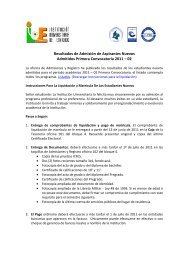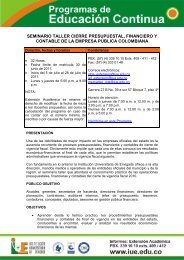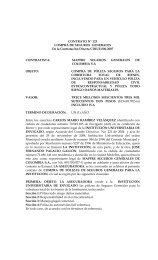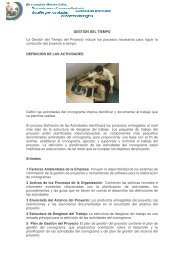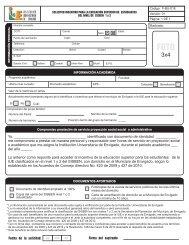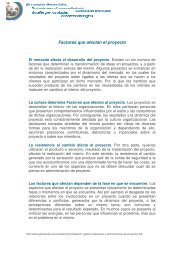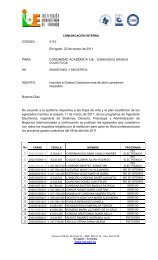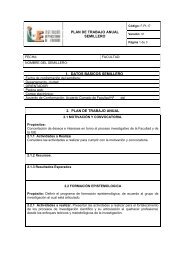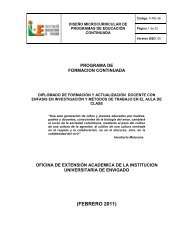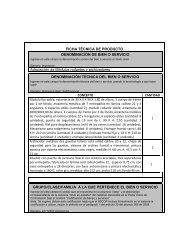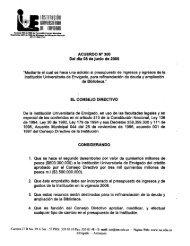Edición N° 11 - Institución Universitaria de Envigado
Edición N° 11 - Institución Universitaria de Envigado
Edición N° 11 - Institución Universitaria de Envigado
You also want an ePaper? Increase the reach of your titles
YUMPU automatically turns print PDFs into web optimized ePapers that Google loves.
74<br />
Gustavo Adolfo Cal<strong>de</strong>rón, Guillermo Alonso Castaño, Ángela María Urrea<br />
Abstract<br />
This speech outlines the influence of social, cultural and political factors that may<br />
be responsible for either the reduction or stabilization in the consumption of certain<br />
substances such as the increase in others. The aim of this study was to i<strong>de</strong>ntify risk<br />
factors associated with alcohol consumption in college women and men stu<strong>de</strong>nts.<br />
They were measured on the basis of a <strong>de</strong>scriptive study conducted during 2010. The<br />
chi-square test by Pearson was used to analyze the relationships between variables.<br />
The results confirmed the influence of peers and the consumption of psychoactive<br />
substances by any member of the family.<br />
Keywords: risk factors, college drinking.<br />
1. Introducción<br />
En la actualidad asistimos a una creciente <strong>de</strong>manda <strong>de</strong> información<br />
sobre los patrones <strong>de</strong> consumo <strong>de</strong> alcohol en la sociedad, por la<br />
problemática social y personal que plantea. Dentro <strong>de</strong> estos patrones<br />
adquieren una mayor importancia los asociados a las pautas <strong>de</strong> consumo<br />
<strong>de</strong> la adolescencia y juventud, que van aumentando tanto en el número<br />
<strong>de</strong> bebidas adquiridas, como en el <strong>de</strong> su graduación alcohólica.<br />
El uso <strong>de</strong> sustancias psicoactivas es motivo <strong>de</strong> preocupación por<br />
provocar problemas <strong>de</strong> salud pública <strong>de</strong> gran impacto mundial. El<br />
incremento <strong>de</strong> la población vulnerable (jóvenes), <strong>de</strong> los factores <strong>de</strong><br />
riesgo <strong>de</strong>rivados <strong>de</strong> las transiciones sociales y <strong>de</strong> la disponibilidad <strong>de</strong><br />
las drogas, se han propuesto como factores que condicionan el aumento<br />
en el número <strong>de</strong> nuevos usuarios y la disminución en su edad <strong>de</strong> inicio<br />
(Sepúlveda, 2000).<br />
La adolescencia, <strong>de</strong>finida como la etapa entre la niñez y la edad adulta<br />
(<strong>de</strong> los 10 a los 19 años <strong>de</strong> edad) constituye uno <strong>de</strong> los momentos más<br />
vulnerables <strong>de</strong>l ser humano para <strong>de</strong>sarrollar costumbres y hábitos<br />
<strong>de</strong> riesgo para su salud, entre los que se <strong>de</strong>stacan el alcoholismo, el<br />
tabaquismo y la farmaco<strong>de</strong>pen<strong>de</strong>ncia (Caballero y Cols, 1999). La<br />
evi<strong>de</strong>ncia epi<strong>de</strong>miológica nacional e internacional reconoce que el<br />
uso ocasional o continuo <strong>de</strong> alcohol y tabaco, solos o combinados,<br />
permanece reiteradamente entre la gente joven (Kosterman y Cols.,<br />
Katharsis





